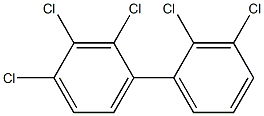Chemical Properties
Light-yellow viscous liquid; approxi-
mately 4.96 chlorine atoms per molecule.
Physical properties
Light yellow, viscous, oily liquid with a faint odor
Uses
Dielectric in capacitors and transformers;
investment casting processes; heat exchange
fluid; hydraulic fluid; no longer
produced in the US
Uses
Secondary plasticizer for polyvinyl chloride; co-polymers of styrene-butadiene and
chlorinated rubber to improve chemical resistance to attack. In fluorescent and high-intensity
discharge ballasts manufactured prior to 1979 (U.S. EPA, 1998).
Sealing electrical bushings and terminals. Used instead of silicone oils in vacuum pumps. May
have been added to automotive transmission oils to swell shrunken transmission seals in place.
Ingredient in emulsifiable-type cuttings oils to increase heat resistance (Monsanto, 1960).
At a concentration of 5 to 25 wt %, increased the effective kill-life of the lindane spray up to 10
times. May have been used in chlordane and BHC insecticide formulations. In polyurethane resin
adhesive adhesive containing 16 wt % PCB-1254. Also in formulations plasticized with 3 parts
dioctyl phthalate and 1 part PCB-1254 to increase chemical resistance of various polyvinyl
chloride (Monsanto, 1960.)
Definition
ChEBI: A mixture of polychlorobiphenyls of unspecified composition, containing 54% chlorine (X = Cl or H).
Hazard
Toxic, carcinogen.
Health Hazard
Chlorodiphenyl, 54% chlorine
(Arochlor 1254) , a polychlorinated biphenyl or
PCB, is an irritant of the eyes and mucous membranes. It is toxic to the liver of animals,
and severe exposure may produce a similar
effect in humans. It also causes an acneform
dermatitis (chloracne). It is a liver carcinogen
in animals.
Safety Profile
Confirmed carcinogen
with experimental carcinogenic and
neoplastigenic data. Poison by intravenous
route. Moderately toxic by ingestion and
intraperitoneal routes. Experimental
teratogenic and reproductive effects.
Mutation data reported. When heated to
decomposition it emits toxic fumes of Cl-. Used in heat transfer, hydraulic fluids,
lubricants, and insecticides. See also
POLYCHLORINATED BIPHENYLS.
Environmental Fate
Biological. A strain of Alcaligenes eutrophus degraded 35% of the congeners by dechlorination
under anaerobic conditions (Bedard et al., 1987). Indigenous microbes in the Center Hill
Reservoir, TN oxidized 2-chlorobiphenyl (a congener present in trace quantities) into
chlorobenzoic acid and chlorobenzoylformic acid. Biooxidation of the PCB mixture containing 54
wt % chlorine was not observed (Shiaris and Sayler, 1982).
Soil. In two California soils (foc = 0.3 and 11.3%), 95% of the applied amount was recovered
after 1 yr with no change in the congener composition. In the four remaining soils containing less
organic carbon (0.06 to 1.9%), degradation resulted in preferential loss of congeners with the
lowest molecular weight (Iwata et al., 1973).
Photolytic. PCB-1254 in a 90% acetonitrile/water solution containing 0.2–0.3 M sodium borohydride
and irradiated with UV light (λ = 254 nm) reacted to yield dechlorinated biphenyls. After
16 h, no chlorinated biphenyls were detected. Without sodium borohydride, only 25% of
PCB-1254 were destroyed after 16 h (Epling et al., 1988). In a similar experiment, PCB-1254
(1,000 mg/L) in an alkaline 2-propanol solution was exposed to UV light (λ = 254 nm). After 30
min, all of the PCB-1254 isomers were converted to biphenyl. When the radiation source was
sunlight, only 25% was degraded after a 20-h exposure. But when the sensitizer phenothiazine (5
mM) was added to the solution, photodechlorination of PCB-1254 was complete after 1 h at 350
nm. In addition, when PCB-1254 contaminated soil was heated at about 80 °C in the presence of
di-tert-butyl peroxide, complete dechlorination to biphenyl was observed (Hawari et al., 1992).
Chemical/Physical. When PCB-1254-contaminated sand was treated with a poly(ethylene
glycol)/potassium hydroxide mixture at room temperature, 81% reacted after 6 d forming aryl
poly(ethylene glycols) (Brunelle and Singleton, 1985).
Solubility in water
(wt %): Pyridine (114 at 31 °C), diglycol monoethyl ether (173 at 26 °C), methanol (15 at 26 °C), ethanol
(10 at 27 °C) (Monsanto, 1960)



